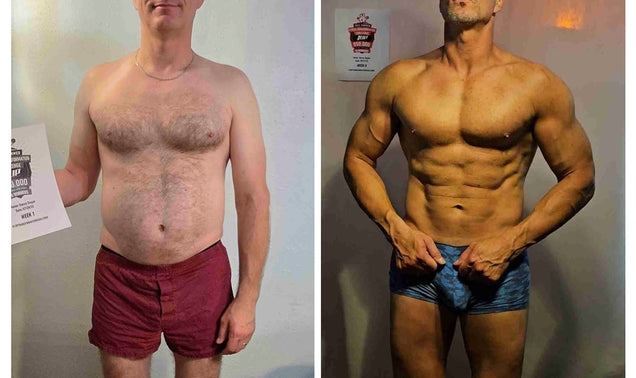There’s no better sensation than the satisfaction at crushing a tough workout.
Endorphins are flowing, sweat is dripping, and you feel like you’re on top of the world.
While you think your muscles might be finished working when you head to the showers, the reality is that their work is just beginning as they set out to repair the damage done during the workout, replenish energy stores, and grow stronger.
Today, we discuss what happens in the hours after your workout.
So, let’s get started!
What is Muscle Recovery?
Intense exercise (HIIT, resistance training, sprinting) ignites a flurry of metabolic activity in the body.
The most obvious side effect of intense exercise is the damage done to muscle fibers. The more intense and longer the workout, the more micro-trauma that occurs.
And, if you’ve ever pushed the envelope too far, you know all too well the debilitating soreness that ensues. Even rolling out of bed can seem like a chore when you’re horrifically sore from a workout.
These muscle aches that arise the day or two after a hard workout are called delayed-onset muscle soreness, or DOMS for short.
To repair the damaged muscle fibers, your body goes through two distinct recovery phases:
- Regeneration
- Resolution
During recovery, satellite cells travel to the damaged muscle fibers and start to rebuild and repair. This repair process continues as long as a messenger compound, called an “inflammatory mediator”, is there to instruct the body to get to work repairing damaged fibers.
The Resolution phase begins while the regeneration phase is winding down. During resolution, the repaired muscle fibers finish recovery, allowing strength levels to return to normal.
When soreness gets very bad, individuals may be tempted to take non-steroidal anti-inflammatory drugs (NSAIDs) to ease the pain.
However, acute inflammation is a normal (and necessary) part of the recovery process. Taking NSAIDS can stop inflammation, which ultimately impairs recovery and growth.
How Long Does it Take Muscles to Recover?
How quickly a muscle recovers depends on a number of factors, including:
- Genetics
- Gender
- Training experience
- Training volume
- Training intensity
- Sleep habits
- Stress levels
- Nutrition
- Type of exercise (endurance, HIIT, resistance training, etc)
Assuming all of those are on point, muscles recover between 24-72 hours following training.
Higher intensity training protocols (plyometrics, HIIT, sprinting, etc.) take longer to recover from than lower intensity forms of exercise (walking, jogging, cardio, etc).
Eccentric training is particularly stressful to skeletal muscle tissue, causing more micro-tears, damage, and DOMS than just about any other form of resistance training.
Is Soreness Necessary to See Results?
For the longest time, it was believed that unless you were horrendously sore for 2-3 days after a workout, it wasn’t effective.
That story has changed in recent years. Chasing soreness can often result in individuals performing too much volume and intensity, creating so much damage to the muscle tissue that your body spends all its recovery resources just repairing the damage that was done, instead of growing bigger and stronger.
If you start a new training program or add a new exercise into your existing training program, a little bit of soreness is expected.
But, chasing soreness for the sake of being sore isn’t the way to making optimal progress in your training program.
To make progress, you simply need to do more work than you did the last time you trained. In order to know whether or not you did more work, you need to record your sets, reps, weights, and exercises.
This way you have a log of what you’ve done, and a goal for what to do the next time you enter the gym.
Basically, soreness can be an indicator of a good/effective workout, but just because you may not get sore from a particular training session doesn’t mean it was a “bad” workout or ineffective.
Some people just naturally get more sore than others.
How to Reduce Soreness and Improve Recovery
#1 Make Sure You’re Eating Enough Calories
Recovery requires energy, and your body gets energy from the foods you eat.
Therefore, the first thing you need to do to maximize your recovery is to make sure you’re eating enough total calories each day.
This also means that you need to pay extra attention to your nutrition when dieting as calories will be at a premium, which may lead you to having slightly slower recovery and/or more soreness.
#2 Consume Adequate Protein
Muscles are made of protein and the body uses amino acids (from the protein you eat) to repair the damage.
After ensuring that you’re consuming enough calories, the next thing you need to make sure of is that you’re consuming enough protein each day.
A good goal to aim for is ~1 gram per pound of bodyweight per day.
So, if you weigh 150lbs, you will want to consume 150 grams of protein per day.
This can come from a combination of foods, including beef, chicken, pork, fish, shellfish as well as protein powder.
Protein powder offers a quick, affordable, hassle-free and delicious option for those on-the-go individuals.
1UP offers an extensive array of high-quality protein powders, including both whey protein and vegan protein powder options.
#3 Consume Enough Carbohydrates
Carbohydrates are the preferred source of energy for high-intensity exercise.
Glycogen is the storage form of carbohydrate in skeletal muscle tissue.
Intense training sessions can deplete glycogen stores, which can lead to fatigue and soreness.
In fact, research notes that decreased glycogen stores lead to muscle fiber stiffness.[1]
Replenishing glycogen stores after a hard training can help facilitate the recovery process and increase the uptake of key amino acids and protein (like the kind found in protein powder).
One of the best ways to get a jump-start on the recovery process is by using a fast-digesting carbohydrate supplement, like 1UP TRI Carb.
TRI Carb contains a synergistic blend of three rapid-digesting, high-performance carbohydrates in Cluster Dextrin®, Carb10™ & MODCARB®.
We’ve also fortified TRI Carb with electrolytes to restore hydration and help reduce muscle cramping.
#4 Take a Bath
Epsom salt and ice water baths are both widely used by athletes looking to reduce soreness and accelerate recovery.
Another option is called “contrast therapy”, where you alternate between bathing in warm and cold water.
Research has shown that contrast water therapy can significantly reduce DOMS.[2]
#5 Walk
Walking is one of the best things you can do for recovery that also supports muscle building and fat loss.
It is low intensity, so it won’t eat into your muscles ability to recover from intense resistance training/HIIT sessions.
Walking also increases circulation, which accelerates the recovery process and may help reduce DOMS as well.
#6 Get Enough Sleep
Getting enough sleep is vital to recovery as it is when we sleep that the body does the vast majority of its repair and recovery work.
Not getting enough sleep increases cortisol levels and muscle protein breakdown -- both of which reduce recovery and increase soreness.
Aim to get 7-9 hours of quality sleep each night to help maximize your body’s ability to recover and grow.
Need help falling and staying asleep? Try Recharge PM for men or Beauty Dream PM for women
References
- Nelson MR, Conlee RK, Parcell AC. Inadequate carbohydrate intake following prolonged exercise does not increase muscle soreness after 15 minutes of downhill running. Int J Sport Nutr Exerc Metab. 2004;14(2):171-184. doi:10.1123/ijsnem.14.2.171
- Dupuy O, Douzi W, Theurot D, Bosquet L, Dugué B. An Evidence-Based Approach for Choosing Post-exercise Recovery Techniques to Reduce Markers of Muscle Damage, Soreness, Fatigue, and Inflammation: A Systematic Review With Meta-Analysis. Front Physiol. 2018;9:403. Published 2018 Apr 26. doi:10.3389/fphys.2018.00403






